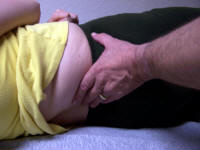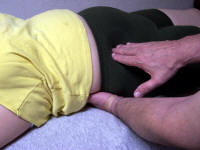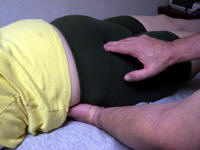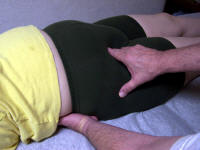 Winning Hands Massage
Winning Hands Massage
Short Leg Syndrome (Contracted PSOAS)
Every time I hear/read about someone with one leg shorter than the other,
the first question that comes to my mind is "is it structural or
functional?" Specifically, is one leg structurally shorter in that there is
a MEASURED, physical difference in bone length, one leg to the other? Or is
it functional, such that supine on a table, the heels don't line up against
each other? Treatment options and protocols are considerably different, one
type versus the other. In addition, there is also a difference in approaches
taken to "fix" the problem, depending on type of health care provider that
you are seeing. I can think of a number of possible causes for both,
including skeletal, muscular, fascial, visceral and ligamentous. I can also
think of a number of possible, complimentary treatment protocols. Reference
points are the soles of the feet, ankle bones (medial malleoli), knees and
hips. Braces, orthotics and “adjustments” simply address specific symptoms.
They do nothing to fix the root problem. Another one of my pet peeves –
address the symptom and ignore the problem.
One possibility is a unilateral shortening of the Psoas. A second could be a
chronically contracted Quadratus Lumborum muscle on just one side (this, by
the way, would also contribute to a scoliotic posture as the body
compensated to keep the head in a mid-line position). A third could be a
jammed SI joint causing a pelvic tilt or rotation. And a fourth could be
contractures in any of the muscles that abduct the hip (pull it out and away
from the body)? Then, of course, there is always the possibility of fascial
restrictions that cause any of the above muscles to dysfunction. In
deference to your chiro, we can’t forget that you could have subluxed lumbar
vertebrae. There could also be visceral issues such that some of the
ligamentous attachments at the posterior abdominal wall exert an anterior
and/or lateral pull on specific vertebral segments. ANY of the above fascial
and/or muscle dysfunctions could exert sufficient force over time to sublux
the lumbar vertebrae or screw up the SI joint.
A couple of things have really been driven home for/to me in the last couple
of years taking continuing ed classes. The main one is that the human body
is a SYSTEM, made up of interrelated sub-systems. Dysfunction in any one of
those sub-systems has potential to affect ALL of them – and the CAUSE is
quite frequently totally unrelated to the SYMPTOM. The other thing is that
the more specialized ANY “provider” gets, the greater their tendency to view
ALL problems through whatever set of glasses they themselves wear, both in
terms of diagnosis and treatment. Chiros are notorious for this because they
tend to view EVERYTHING as a function of spinal misalignment. But the
tendency is not limited to Chiros – it is more common than I like to think
about and it cuts across all of the health care fields. I see exactly the
same mind-set in various bodywork modalities.
Let's start with specific location. The full name is the iliopsoas,
consisting of the psoas major and iliacus muscles. Psoas Major originates on
the bodies and transverse processes of the lumbar vertebrae. It inserts on
the lesser trochanter of the femur (a bony protrusion on the inside of the
femur, just below the head of the femur). The iliacus originates on the
iliac fossa (the entire inner surface of the pelvic bone). It also inserts
on the lesser trochanter of the femur. Both muscles flex, laterally rotate,
and adduct the hip joint.
When dysfunctional, they can be the source/cause of all kinds of problems.
They can contribute to lower back pain as well as cause a posture of
anterior pelvic tilt. If you look at someone side-on, the ASIS (Anterior
Superior Iliac Spine) of the pelvis should be in direct vertical alignment
with the pubic symphysis – lower center point of the pubic bone. With
anterior pelvic tilt, the ASIS (top of the pelvis) is anterior or forward of
that vertical line, causing the arched back posture. A posterior pelvic tilt
is just the opposite. The pubic bone is ahead of the vertical line and the
top of the pelvis is toward the rear, causing an abdomen thrust forward
posture. Anterior pelvic tilt and lordosis are just two of the effects of a
contracted PSOAS. Because of the direction of force that they exert when
contracted, they can also contribute to hip subluxation problems
The first photo below shows where I place the one hand along the spine. The
next three show successive hand positions on the front of the body.
What particularly saddens and infuriates me (depending on my mood when I
think about it), is a study I read about that was released in 2002. In
brief, it discussed the prevalence of legs of unequal length contributing to
osteoarthritis, not only of the knee but the hip as well. The main
recommended treatment was prescription of special orthotics to correct the
leg length differential. One more case of treating the symptom and never
finding the cause.
Home Page |
Mike's Biography and Training |
Treatment Information |
Mike's Recommendations |
Mike's Writing
(c) 2005-2007 Mike Uggen,
Phone: (317) 297-7263
Cell: (317) 508-8556
WA License Number 16912
Web Design by Barbara Uggen-Davis
 Winning Hands Massage
Winning Hands Massage Winning Hands Massage
Winning Hands Massage


